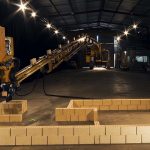 Last year I wrote about a number of innovations emerging in the construction industry, from the drones that track project progress to the use of augmented reality to do likewise, or even the wearable device that aims to ensure workers are not exposed to hazardous materials.
Last year I wrote about a number of innovations emerging in the construction industry, from the drones that track project progress to the use of augmented reality to do likewise, or even the wearable device that aims to ensure workers are not exposed to hazardous materials.
Perhaps the most visceral technology was the robotic bricklayer (or semi-automated mason if you prefer it’s actual title) that has been developed to power construction sites around the world.
“In construction, your design will say that a window is located exactly 30 feet from the corner of a building, and in reality when you get to the building, nothing is ever where it says it’s supposed to be,” its developers say. “Masons know how to adapt to that, so we had to design a robot that knows how to do that, too.”
Building Hadrian’s Wall
A 2nd machine of this ilk is called Hadrian X (after the Roman emperor who built the wall between England and Scotland). The makers claim that it will be able to lay around 1,000 bricks per hour, or a shell of a building in around two days. The equivalent for human brickies is around six weeks.
The device has been built by Australia’s Fastbrick Robotics, and is the 2nd iteration of the model. The company claim that the device is capable of ensuring each brick is perfectly shaped for their specific location on the project. What’s more, it can do this without any human intervention.
The process begins by analyzing a 3D layout of the building it will be working on. From here, it gauges the size and location of each brick required. The bricks are then loaded onto Hadrian, whereby they will be cut to the required shape.
The bricks then travel along a belt inside the arm of the machine and are placed in the desired location using laser guidance. It’s capable of knowing the exact space required for fixtures such as windows and doors, thus making it easier for these features to be added.
The makers claim that using Hadrian X will shave around 6 weeks off of the time required to build a standard home, although it’s likely to be 2017 before a full-scale house is constructed using the device.
Suffice to say, it’s likely to be a while before we see the likes of Hadrian or SAM on the majority of building sites, and they remain at an early stage of their development. What they highlight however is the progress being made in a relatively challenging domain.
Check out the video below to see Hadrian in action.